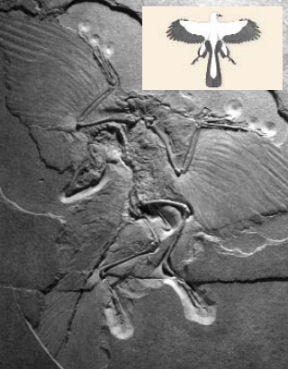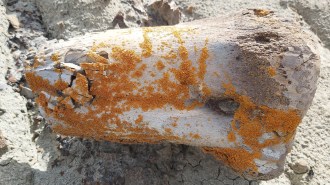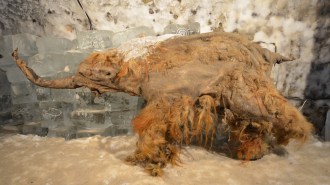Flying with Their Legs: Hind feathers made primitive bird nimble
- More than 2 years ago
The earliest-known bird may have soared ancient skies on four wings. Feathers covered the legs of Archaeopteryx, a creature that lived 150 million years ago and had wings like modern birds but teeth and claws like dinosaurs. A new report argues that Archaeopteryx used these leg feathers to improve its flight.

Scientists had assumed that the Archaeopteryx‘s leg feathers were for warmth and streamlining. But when Nick Longrich of the University of Calgary in Alberta reexamined a fossil of the creature, he found that its leg feathers resembled the ones that keep modern birds aloft. Thus, he argues in the summer (September) issue of Paleobiology, the legs functioned like small auxiliary wings, providing extra lift that made the creature more nimble in the air.
Longrich became interested in Archaeopteryx‘s hind limbs 3 years ago, when a primitive-bird fossil was discovered in China. It had large feathers on its legs that its discoverers argued played a role in flight (SN: 1/25/03, p. 51: Wings Aplenty: Dinosaur species had feathered hind limbs). He wondered whether the same was true for Archaeopteryx. “It had never occurred to me to look at the hind limbs,” he says.
An Archaeopteryx fossil found in 1877 had initially shown feathers on its legs. But those feathers obscured the bone, so they were stripped away when the relic was prepared for display.
Evidence of the feathers still existed, though. When paleontologists split the rock to reveal the fossil, the face opposite the bone retained a counterimpression—including the leg feathers. When Longrich examined this slab, which had been in storage at the Humboldt Museum in Berlin, he saw the leg feathers.
Longrich was uncertain whether the feather-covered rear legs could splay outward, mimicking the position of the wings, or whether the creature’s hips kept its back legs straight down, unable to assist in flight. Longrich combined digital photographs of the fossil’s counterimpression to make a computer model of Archaeopteryx‘s flight. He found that the hind legs could provide significant lift even if they couldn’t splay fully outward.
If the feathered legs were held out at 45 degrees, they would enable Archaeopteryx to turn 9 percent more sharply than if the creature’s legs didn’t aid its flight. That position would also reduce by 5 percent the speed at which the bird could fly before it stalled and fell from the air. If the feathered legs were held out at a full 90 degrees, they would decrease the turning radius by 12 percent and the stall speed by 6.5 percent.
“It is an interesting hypothesis, but it’s relatively speculative,” says Peter Makovicky of the Field Museum in Chicago. He notes that hind-limb feathers were apparent on only 1 of the 10 Archaeopteryx fossils that have been discovered.
Luis Chiappe of the Natural History Museum of Los Angeles County says he’s “not convinced” by Longrich’s arguments. Hind-limb feathers of Archaeopteryx could be similar to those of eagles and not play a strong role in flight.







